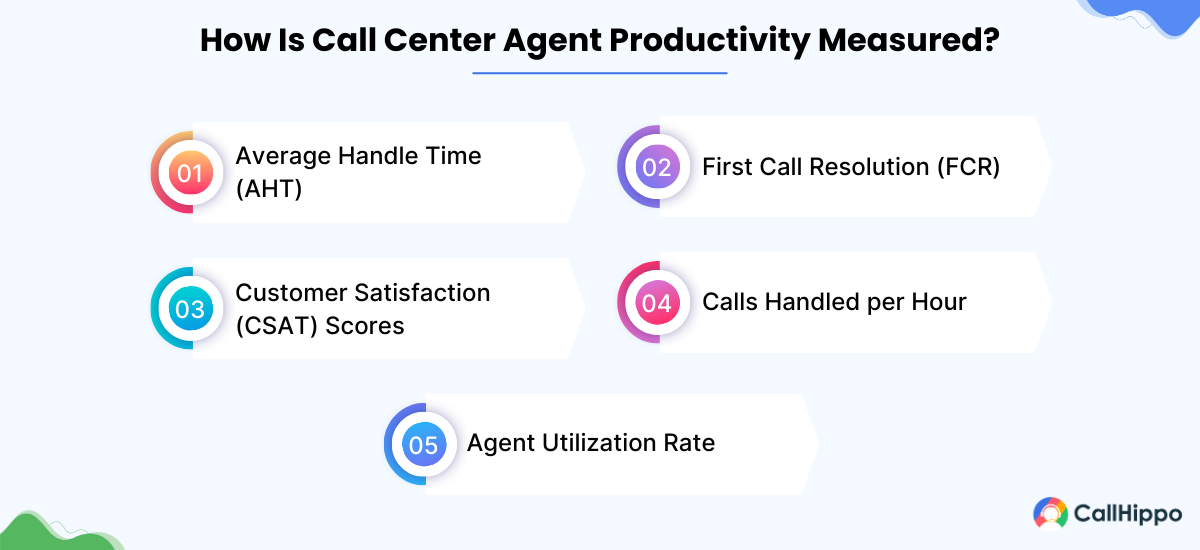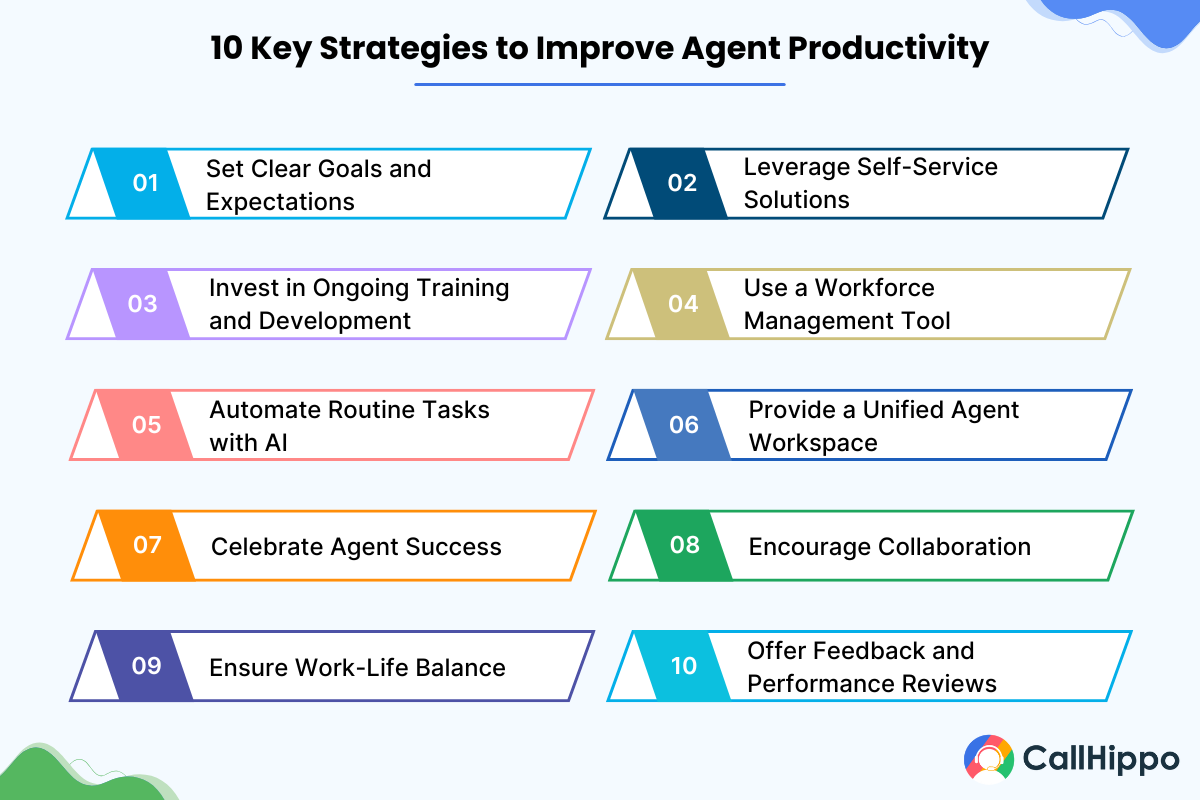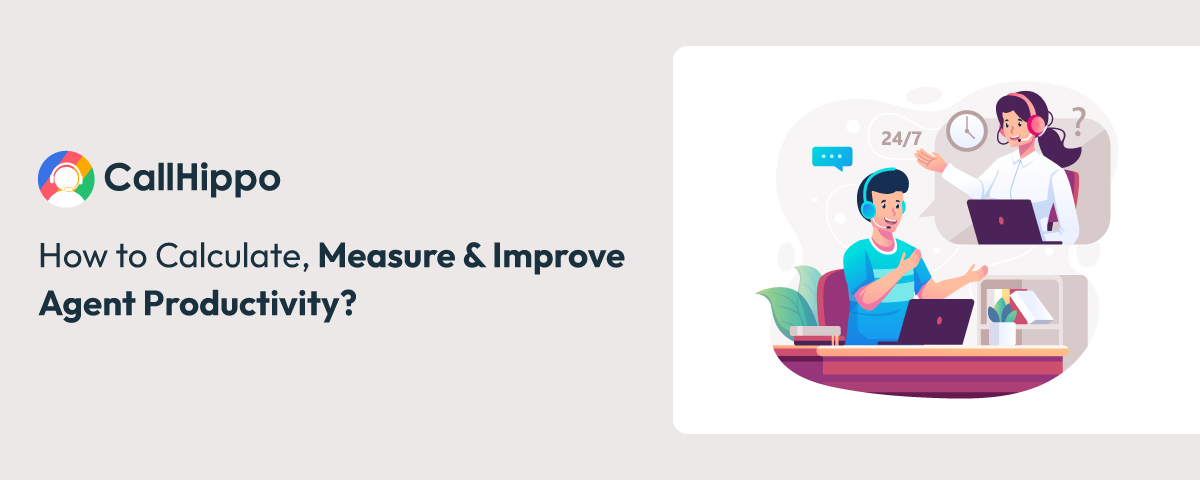Is agent productivity really that important for a successful call center? Absolutely! When agents are more productive, they can respond to customer inquiries more quickly and effectively.
Companies that regularly monitor agent performance have reported a 20% increase in customer retention and a 15% improvement in agent productivity.
Impressive, right? So, what exactly does it take to calculate, measure, and improve agent productivity in a sustainable and impactful way?
Let’s dive in and explore the strategies and metrics that can drive impactful results for your call center team.
What Does Agent Productivity Mean?
Agent productivity in a call center context refers to the efficiency and effectiveness with which customer service agents handle their tasks. A productive agent doesn’t just resolve customer inquiries quickly; they also maintain high-quality interactions that contribute to customer satisfaction.
It’s about balancing speed with quality, ensuring that agents can handle a high volume of calls without sacrificing the quality of service. To achieve this balance, it’s essential to also improve agent engagement.
As engaged agents are more likely to deliver consistent and effective service, especially during times of high call center overflow. Managing call center overflow effectively helps agents stay focused and productive. By implementing strategies such as automated routing and overflow call handling, businesses can ensure that customer inquiries are addressed promptly.
In addition to these customer-facing resources, your company can provide a self-service option for its agents by developing an internal knowledge base using employee experience software.
How Do You Measure Call Center Agent Productivity?
Measuring call center agent productivity involves analyzing several key performance indicators (KPIs). Here are some of the most relevant metrics to measure agent productivity:

1. Average Handle Time (AHT)
AHT measures the average duration an agent spends on customer interaction, including hold time and after-call work. The handling time for one call is the time taken from the call initiation to disconnecting the call.
It’s calculated by dividing the total time spent on calls by the number of calls handled. Lower AHT can indicate higher efficiency but may also lead to rushed calls, so it’s important to balance AHT with quality.
Formula:

Example: An agent handling 100 calls in a shift with a total handle time of 600 minutes has an AHT of 6 minutes per call.
2. First Call Resolution (FCR)
When an agent resolves a customer’s query on the first call, it’s called First Call Resolution (FCR) or First Contact Resolution. It’s another essential metric to measure agent efficiency and performance, and in a support-based call center, FCR is one of the Call Center KPIs to measure an agent’s performance.
When you solve customer queries on the very first call, they’re more likely to be happy with your service level and share positive feedback. The standard benchmark for FCR is 70-75%.
FCR Formula:

3. Customer Satisfaction (CSAT) Scores
A customer satisfaction (CSAT) rate is an important marketing and call center KPI that assesses how satisfied a customer is with the company’s service or product. The outcome that results helps firms understand how well their products or services are doing and what needs to be done to improve customer satisfaction.
CSAT scores are collected through post-interaction surveys that measure customer satisfaction on a scale, often from 1 to 5. It is one of the most direct indicators of how well agents meet customer expectations.
CSAT Formula:

4. Calls Handled per Hour
This metric indicates the number of calls an agent can manage in an hour. It helps determine productivity levels but should be monitored in combination with customer satisfaction to avoid sacrificing quality for speed.
The formula for calculating Calls Handled per Hour is:

Example
If an agent handles 80 calls in an 8-hour shift, the Calls Handled per Hour would be: 80 calls ——— = 10 calls per hour 8 hours
5. Agent Utilization Rate
Agent Utilization Rate calculates the percentage of an agent’s shift spent on productive tasks like calls rather than idle time.
A utilization rate of around 75% is generally considered ideal, balancing productivity with agent well-being.
The formula for calculating the Agent Utilization Rate is:

Example:
If an agent spends 6 hours on calls out of an 8-hour shift, their utilization rate would be: ( 6 hours) ———- x 100 = 75% ( 8 hours )
10 Strategies to Improve Agent Productivity
To increase agent productivity while making sure they feel valued and supported, it’s essential to implement some effective strategies. Here are a few practical tactics you can try:

1. Set Clear Goals and Expectations
Defining clear goals helps agents understand what is expected and provides them with targets to work toward.
To make these goals effective, ensure they are SMART: Specific, Measurable, Achievable, Relevant, and Time-bound. For instance, rather than a vague goal like “improve productivity,” a SMART goal might be “reduce Average Handle Time by 10% within the next quarter.”
This clarity gives agents a concrete objective, a clear way to measure success, and a realistic timeline to work within.
“Setting goals is the first step in turning the invisible into the visible.” – Tony Robbins (American motivational speaker and life coach)
2. Leverage Self-Service Solutions
Just because a customer has a question doesn’t mean an agent always has to interfere. By providing customer self-service solutions, you can decrease ticket volume and help improve agent and call center efficiency while offering customers a way to independently resolve their issues.
Self-service options empower customers, allowing them to find answers quickly and conveniently, which can improve the overall customer experience.
Examples of effective self-service solutions include:
- Knowledge Base Software
- FAQ Page
- Community Forum Software
- Automated Call Center Software
3. Invest in Ongoing Training and Development
Providing ongoing training keeps agents updated with the latest skills and technologies, helping them work more efficiently. Regular training also boosts morale and encourages agents to stay engaged with their work.
Here is an example of a training schedule for enhancing agent skills.
This comprehensive schedule aims to equip agents with the necessary tools and knowledge to improve customer interactions and overall service quality.
4. Use a Workforce Management Tool
Implementing a Workforce Management (WFM) technology can significantly improve productivity in call centers. These solutions automate staff scheduling, track agent performance, and optimize resource allocation by matching the appropriate number of agents to expected call volumes.
- Companies that use WFM tools report a 15-20% improvement in workforce efficiency and a substantial reduction in operational costs.
With a WFM tool, managers can forecast call volumes based on historical data, identify peak hours, and create schedules that ensure the right coverage at all times. This resulted in improved agent performance in call center.
5. Automate Routine Tasks with AI
Automation tools powered by AI help improves productivity by handling repetitive tasks like logging call details and processing basic requests.
By reducing the amount of routine work, agents can focus on complex interactions, thereby increasing productivity. Here’s how AI can streamline operations in a call center:
- Automated call routing
- Chatbots for simple inquiries\
- Sentiment analysis for customer insights
- Predictive analytics for proactive service
- Automated reporting and performance tracking
- Speech-to-text transcription
6. Provide a Unified Agent Workspace
A unified workspace consolidates all tools and resources on a single platform, allowing agents to access customer data and interact across multiple channels without switching systems.
This setup reduces time spent on administrative tasks and helps agents resolve queries faster.
Why is a unified workspace a productivity booster?
Because it provides;
- Streamlined access to information
- Better collaboration
- Consistent workflow
- Real-time analytics
7. Celebrate Agent Success
Recognizing and celebrating agent achievements is essential for boosting morale, improving job satisfaction, and encouraging sustained productivity.
Acknowledging hard work not only makes agents feel valued but also fosters a positive work environment where everyone feels motivated to perform at their best.
Here’s how celebrating agent success can make a difference:
- Companies with strong employee recognition practices report 27% higher profit margins than those without. (source)
- Organizations with a strong culture of recognition see a 31% lower voluntary turnover rate and up to 60% higher employee engagement. (source)
8. Encourage Collaboration
Another powerful way to improve agent productivity is by fostering seamless collaboration across teams. When agents can easily communicate and collaborate with one another, they’re able to solve customer issues more efficiently and maintain a unified approach to service.
Some collaboration solutions integrate directly with platforms like Slack, Zoom, and Asana, enabling agents to stay connected without switching between apps.
Moreover, with an effective employee experience management system in place, agents can get their questions answered quickly and eliminate the hassle of long email chains.
9. Ensure Work-Life Balance
Maintaining a healthy work-life balance is crucial for agent productivity and well-being.
Agents who feel overworked are more likely to experience burnout, which can lead to decreased performance, higher absenteeism, and even turnover.
By supporting a balance between work responsibilities and personal life, companies can foster a more engaged, motivated, and productive workforce.
Here are a few ways to maintain a great employee experience.
https://webcdn.callhippo.com/blog/wp-content/uploads/2025/01/how-to-ensure-employee-well-being.png
10. Offer Feedback and Performance Reviews
Providing regular feedback and conducting performance reviews are essential for keeping agents on track, helping them grow, and ultimately improving productivity.
By making feedback a regular practice rather than a once-a-year event, companies create a culture of continuous improvement and open communication.
Conclusion
Improving call centre agent’s productivity is vital to deliver exceptional customer service. By setting clear goals, leveraging self-service solutions, and fostering collaboration, companies can enhance agent performance.
Regular feedback and performance reviews further support growth and accountability. Ultimately, focusing on how to improve agent productivity in call centers not only leads to better service outcomes but also ensures that agents feel valued, engaged, and motivated to succeed.

Subscribe to our newsletter & never miss our latest news and promotions.









